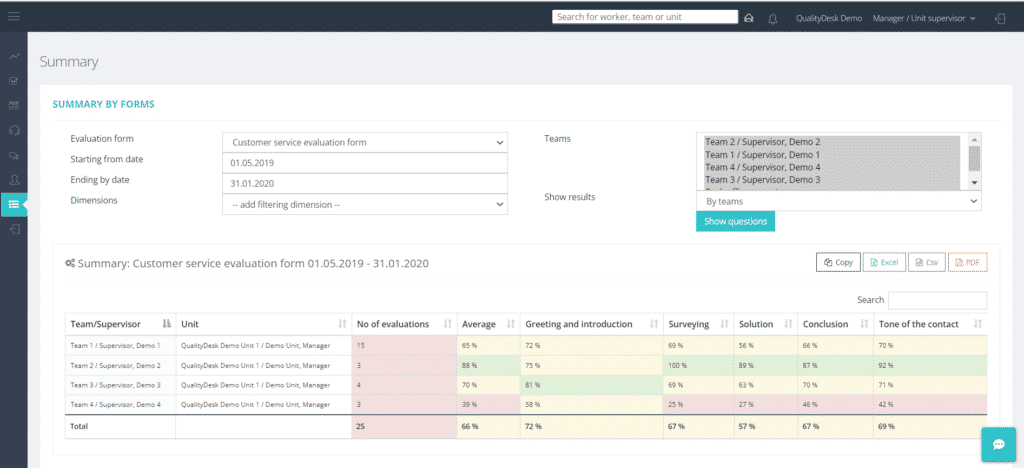What is quality assurance in the context of customer service?
Quality assurance in customer service is a topic that is not often discussed, or if it is, it is misunderstood. Usually what you hear is: “Yes indeed! We are measuring the quality!” When I ask how, the answer is either a) we monitor customers’ opinions of the service and/or b) we are able to monitor effectiveness figures in real time, and we conduct regular customer surveys.
These responses are rather irritating, as they are not about quality assurance. The customer has no way of knowing what the organisation considers a high-quality customer encounter. They are only able to tell you how they felt about it. Similarly, effectiveness figures are not indicators of quality but, as the term suggests, they are indicators of effectiveness, and the results of customer feedback surveys are often already out of date when the data is being analysed.
The aforementioned are, for the most part, important indicators that should be monitored, but only once everyone has a clear understanding of what the quality standards, or quality goals, for customer service actually are!

How are the quality goals of customer service defined?
Here I would like to respond with: “Easily.” However, it might not be so simple in the hustle and bustle of everyday operations. Sometimes it is unclear what needs to be done so that the goals are reached.
And that is the whole point! What must one do in the customer encounter to achieve the desired goals? This is the question that leads to the definition of quality goals. Below is a list of the most common goals for customer service:
Efficiency: The average processing time must be below xx minutes, of which xx seconds is post-processing time.
Response rate: Must be above 80 % or SLA (Service Level Agreement), 80 % of contacts must respond within 20 seconds.
Add-on sales: The value of customership is increased with additional products.
Number of contacts: Must process xx contacts / h.
Customer satisfaction, e.g., NPS must be over 30.
FCR (First Call Resolution) must be above 80 %.
Staff satisfaction must be at a certain level.
Some customer services may even have all of the above goals, and they are regularly monitored. When there are numerous goals that are seemingly unrelated and may even seem to contradict each other, it can be difficult to understand how every goal can be reached.
I argue that quality assurance can ensure that you reach all of your goals. Below I will explain the significance of quality assurance with regard to each of the goals mentioned above.
Efficiency
In order for employees to reach the goals set for the processing time of customer contacts, they must clearly understand what needs to be done during the customer encounter. If the aim is to achieve efficient processing time + excellent customer experience + add-on sales + FCR, it is important to make clear how everything is done in practice.
For this purpose you need to draft a quality assurance form that lists all the things that must be done during the customer encounter so that the desired results are achieved. Systematic quality assurance ensures correct operation, thus also enabling the reaching of the goals. NOTE! You should only set a goal for processing time once the quality goals are clear and quality assurance is conducted systematically in the organisation.
Response rate
The impact of an individual employee may feel quite small when considering SLAs and goals set for response rates. However, in customer service resources are allocated quite precisely and based on an anticipated number of contacts and total processing times. Here quality assurance ensures that only the things that need be done during the customer encounter are done, keeping the processing time of contacts within the anticipated limits.
Add-on sales
How are sales done? In customer service it is often enough to chart the overall situation of the customer, mention a product or service that provides additional value and then ask: “Would you like to purchase this product/service?” However, this is often overlooked as the employee focuses solely on solving the customer’s issue. So here is one item to include in the quality assurance form. This ensures that the right things are done during the customer encounter.
Number of contacts
With this goal I recommend letting go of it entirely. If you don’t want to, then quality assurance keeps the processing times of contacts within limits, thus ensuring as many contacts as possible. This is of course greatly impacted by resource allocation and its verity, the lengths of work shifts, possible changes to resource allocation or the number of calls, etc., which is why this goal might be unnecessary for individual employees. However, this is a good goal to include in outbound call projects.
Customer satisfaction
Regarding customer satisfaction, many people in customer service feel that they cannot have much of an impact if the waiting times are long or if the company’s other services have failed to meet the customer’s expectations. However, this idea is completely wrong as the customer service representative can, in the best case scenario, turn the customer’s situation from poor to excellent!
For this to happen systematically, the customers must be met consistently by each customer service person. If the provided service is not of uniform quality, it is almost impossible to fully understand what causes a poor customer experience. When all customer service persons provide the same level of service, the root causes behind the customer experience are much easier to comprehend.
FCR
You always want to solve the customer’s issue with the first contact. To ensure that this happens as often as possible, the organisation must invest in surveying the customer’s overall situation by asking open questions. This way you gain as much information as possible to help solve the customer’s problem, but also for possible add-on sales. To support the work you should compile a list of questions that customers should always be asked.
Employee satisfaction must be at a certain level
Then last – but in no way the least – comes employee satisfaction. One often runs into the idea that quality assurance is disliked or it is considered overbearing. This is absolutely not the case as the aim of quality assurance is to provide clear goals for the work and help employees conduct their work in the best possible manner. Systematic quality assurance also ensures that employees receive feedback for their own work performance regularly and equally. This has a tremendous positive impact on occupational health and well-being.
You get what you measure
So, in summation, you get what you measure. This is especially true when it comes to the monitoring of operations, i.e., quality assurance. When it is conducted systematically, you are absolutely guaranteed to meet your customer service goals for most of the year.
Simply being aware of the fact there are clear goals for the operations and that their progress is being monitored helps everyone to do the right things. When the right things are done, the desired goals are met.
—
Are you new to customer service quality management or do you want to check if your customer service objectives are up to date? With our Quality objectives e-book, you get to define clear guidelines for your organisation’s customer interactions and quality. You can also use the exercise in the book to create an evaluation form that you can use to monitor customer interactions. This will allow you to shift your focus on coaching sessions from just checking KPI results to contents and improvement of customer interactions
As an end result, you will be able to deliver better customer experiences, increase employee satisfaction and reach your goals more often!




